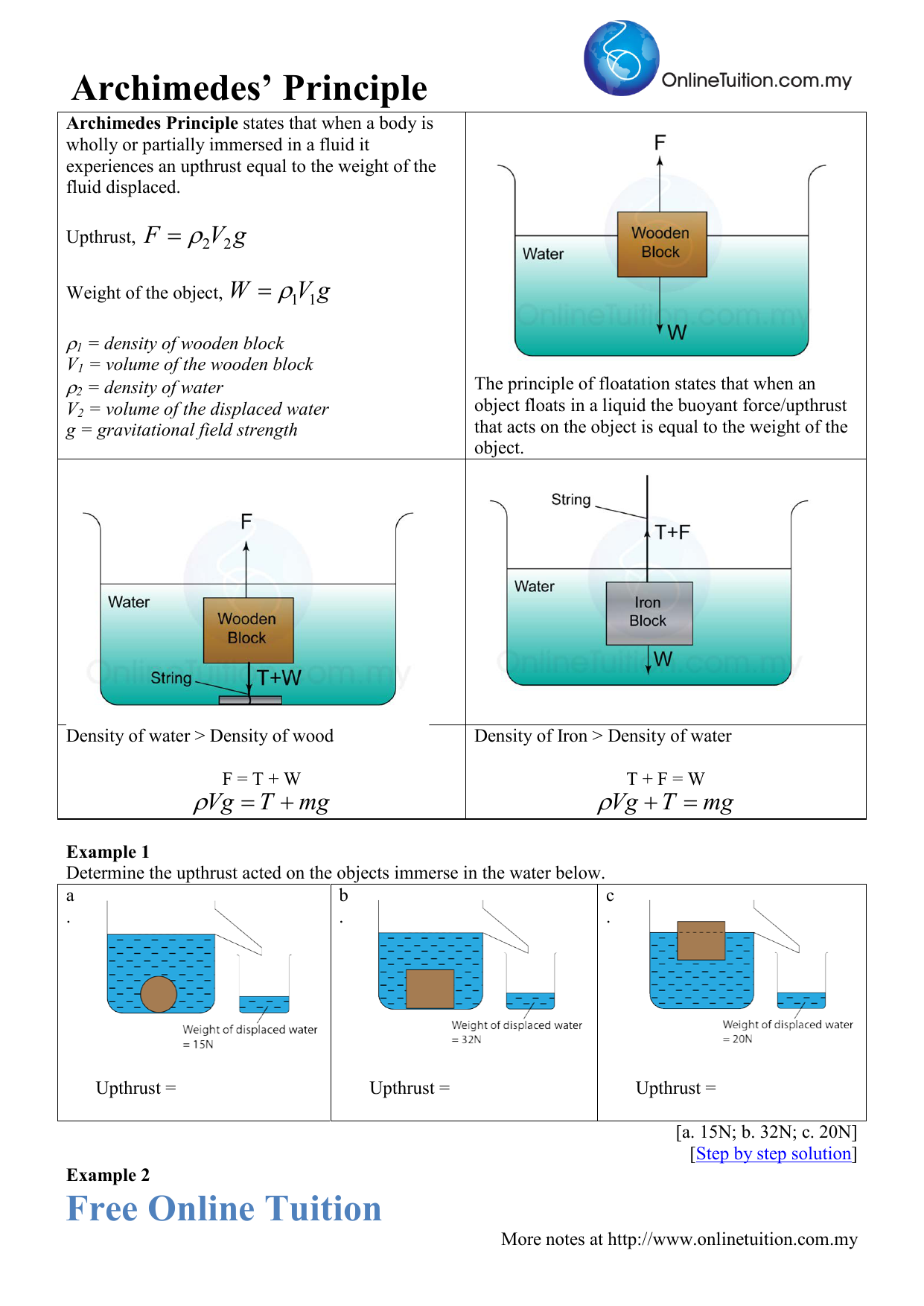
So the downward force is pressure at the top times the area. Same way pressure at the top is pushing down. So the pressure at the bottom, the force that's acting on the object is pushing up because that's what direction, I mean if it's going to push on the object well what's, it's going to push up right? So the upward force is pressure at the bottom times the area, because force is pressure times area. Now pressure is force per unit area, and it points in any direction. The fluid has a pressure in it, so there's a pressure at the bottom and a pressure at the top.
ARCHIMEDES PRINCIPLE EXAMPLE FREE
Alright, so why is Archimedes Principle true? Well we can look at a situation in which we've got an object immersed in a fluid like this, alright now what are the forces acting on this object we're going to draw a free body diagram because we're good Physicists so we've got weight and then we've got 2 forces that are acting from the fluid. So you just need to be careful about that distinction. We'll see that there're equations that you can derive that are perfectly valid when the object is fully submerged but that are not true for floating objects. And that means that its weight has to be canceled by an upward force, what's that upward force? That's the buoyant force, so these are the 2 separate situations and they're entirely separate.

So in the floating situation we always have the buoyant force is equal to the weight of the object because the object is floating. What that means is that the volume displaced is actually less than the whole volume, because some of it, is floating on the top, we said it was floating. If the object is floating on the other hand, then what that means, is that it's not all the way immersed. All I need to know is what's the volume of the object and I'm done. Alright, now so that makes it really, really simple. So that's the volume of the object that's immersed in the fluid times the acceleration due to gravity.Īlright now we have 2 major situations in which we can use Archimedes Principle, if the object is completely submerged, so the entire object is immersed in the fluid then the volume displaced equals the volume of the object. Well what is that? Well it's the density of the fluid times the volume of the volume of the fluid that's benen displaced. So buoyant force equals weight of the displaced fluid. And so what Archimedes said was that, that buoyant force is the weight of how much fluid the object is displacing. Alright so we've got a force from the pressure on the bottom and a force from the pressure on the top we add them together, we want the net force and that's the buoyant force. Now what does a buoyant force mean? The buoyant force, is the net force that is exerted on an object that's immersed in a fluid. So what Archimedes said was that the buoyant force on something is equal to the weight of the displace fluid. Archimedes Principle has been around for a really, really long time and it was very important to rulers of like Greece and Egypt years and years and years ago, and we'll talk about why in just a minute. This is the principle of floatation.Alright let's talk about Archimedes Principle. The upthrust is always equal to the weight of the fluid displaced by the object. In the case of a floating object, the object may be partially immersed. When an object floats in a fluid, the upthrust acting on it is equal to the weight of the object. An object floats if its weight is equal or less than the upthrust.

Thus finding the weight of the solid in air w, and its weight in water w 2, we can calculate the density of solid by the above equation.Ī floating object displaces a fluid having weight equal to the weight of the object.Īn object sinks if its weight is greater than the upthrust acting on it. According to Archimedes law, w 2 is less than its actual weight w 1 by an amount w. Here w 2 is the weight of the solids in a liquid. Weight of equal volume of liquid = w = w 1 – w 2 The ration in the weights of a body with an equal volume of liquid is the same as in their densities. Density Of an Object by Archimedes lawĪrchimedes’s law is also helpful to determine the density of an object.


In the equation that an upthrust acts on the body immersed in a liquid and is equal to the weight of the liquid displaced, which is Archimedes law. Therefore, ρ g V is the weight of the liquid displaced. Here Ah is the volume V of the cylinder and is equal to the volume of the liquid displaced by the cylinder. This net force F on the cylinder is called the upthrust of the liquid. Therefore, the net force F will be F 2 – F 1 in the direction of F 2. F 1 and F 2 are acting on the opposite faces of the cylinder.


 0 kommentar(er)
0 kommentar(er)
